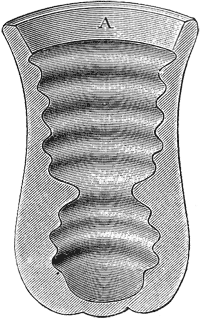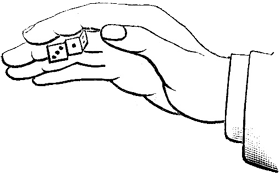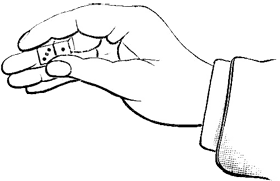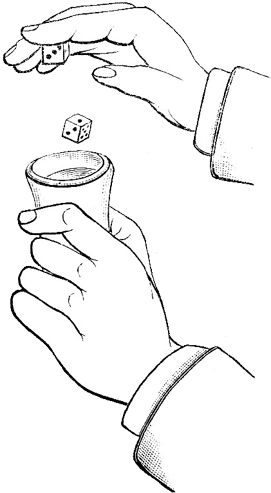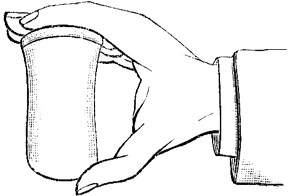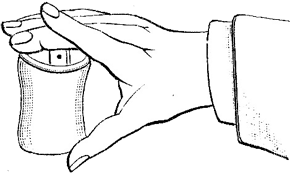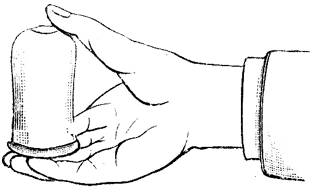
|
foreword to the online edition I. introductory II. common sharpers and their tricks III. marked cards and the manner of their employment IV. reflectors V. holdouts VI. manipulation VIII. the game of faro IX. prepared cards X. dice XI. high ball poker XII. roulette and allied games XIII. sporting houses XIV. sharps and flats
|
SHARPS AND FLATS
CHAPTER X DICE
Cheating with Fair DiceWe will first devote our attention to the means of cheating with fair dice; and the reader will learn that the thing which may have appeared to him as being difficult of accomplishment is really a very simple matter indeed. This branch of the art is known to its professors as 'securing,' and consists of a plan of retaining certain dice. One is held against the inside edge of the box, whilst the other is allowed to fall freely into it. In this way one of the dice is not shaken at all, and falls on the table in the same position as it previously occupied. In order that this may be accomplished satisfactorily, it is necessary to use a suitable dice-box; therefore, we will inspect one of the kind generally used by professional dice-players in this country. Before proceeding further, however, it may be as well to inform the reader that the information here given, with regard to dice and their manipulation, has been had upon the authority of one of the leading English sharps, and may be said to fairly represent the present state of the science. FIG. 47 The dice-box referred to above is illustrated in section in fig. 47. It is simply the usual form, with the interior corrugated to insure the thorough turning about of the dice. The only preparation in connection with it is that the flat inside rim or lip, marked 'A' in the figure, is roughened by rubbing it with coarse glass-paper. This gives it a kind of 'tooth,' which prevents the dice from slipping when they are 'secured' against it.A box of this kind being to hand, nothing further in the way of apparatus is required for the operation of securing. All else depends entirely upon practice. As the dice are taken from the table one of them is secured, and the others are thrown into the box. An expert will use three dice, securing one and letting the others go, but it requires some skill to pick up three dice in the proper manner and without fear of dropping them all. Therefore a novice will use only two. The process is carried out as follows: The dice are laid upon the table side by side. The one farthest from the operator is placed with the ace uppermost, consequently the six is upon the face which lies on the table. This is the die which is about to be secured. The first two fingers of the right hand are now laid flat upon the dice, and between these two fingers the dice are taken up by their right-hand edges. Thus: FIG. 48 They are now pushed well home by the thumb: FIG. 49 The die nearest the operator is now allowed to fall into the dice-box, whilst the other is retained:
FIG. 5O The box is next taken in the right hand, the fingers lying flat over the mouth of it, and the thumb holding it at the bottom. FIG. 51 In the act of closing the ringers of the right hand over the box, the die which has been retained is firmly pressed between the second finger and the inside edge of the box. In this position it is completely hidden by the forefinger, and is there held whilst the box is shaken. If the forefinger were raised the die would appear situated in this manner: FIG. 52 The sharp, however, is particularly careful not to raise his forefinger; that is not 'in the piece' at all. The secured is heard to rattle within it. Finally, the hand is turned round so that the mouth of the box is downwards and the backs of the fingers rest upon the table. FIG. 53 After the box has thus been turned upside down, then comes the crucial point of the whole operation. If the fingers are not carefully removed the secured die will not fall upon the face intended. The proper method of 'boxing' the dice upon the table is to remove the fingers in the following order. Firstly, the second and third fingers are opened, allowing the loose die to fall upon the table. Then the first and second fingers are gently opened, easing the secured die, as it were, into its position of rest. Lastly, the forefinger is moved to the edge of the box, at the same time withdrawing the second finger entirely, and the box is let down over the two dice. It is immediately lilted up and the score is recorded. There is nothing at all suspicious in any of these movements; they are quite the usual thing, or appear so when quickly performed, the only difference between the genuine shake and the false being the retention of the one die. Of course, it is necessary that the entire operation should occupy the least possible time, the hands being kept somewhat low and the dupe seated upon the right-hand side of the operator. The secured die naturally falls with the six uppermost, whilst the loose one cannot show less than one. Therefore the sharp cannot throw less than seven with two dice. That is the lowest score possible for him to make, whilst the dupe may throw only 'two.' Now, in an infinite number of throws with two dice 'seven' is the number of pips which will be the average for each throw. Sometimes, of course, only two pips will be thrown; sometimes both sixes will come uppermost, making twelve pips together. But with one die secured in such a manner as to fall six, the average of an infinite number of throws is necessarily very much increased, because it is impossible to throw less than seven. The chances of the two players bear no comparison, and the dupe is bound to be beaten. For instance, the chances of throwing twelve by the player who secures one die are as one to six that is to say, they are six to one against him, whilst the chances against the player who goes to work fairly are thirty-five to one. This will serve to give the reader some idea of the value of one secured die out of two in use.
|
| « dice | dice (cheating with crooked dice) » |
home | introduction | book content | links | advertising | contact
